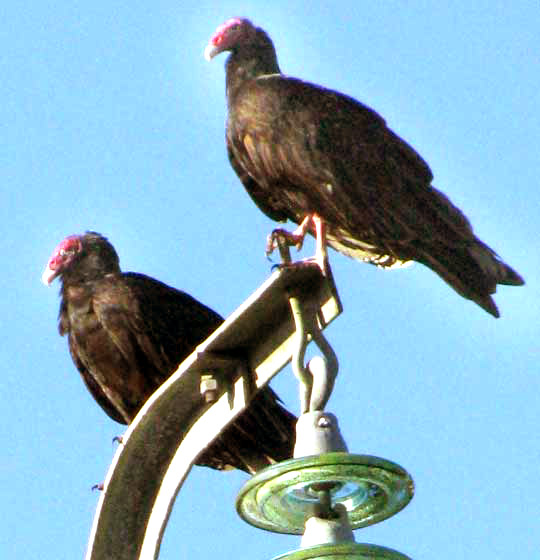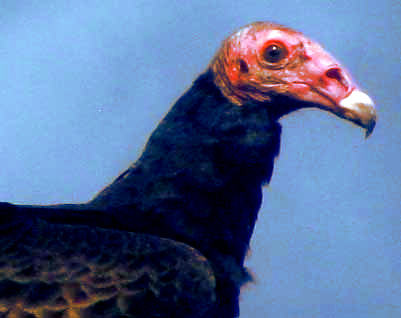Excerpts from Jim Conrad's
Naturalist Newsletter
from the March 6, 2011 Newsletter issued from Hacienda Chichen Resort beside Chichén Itzá Ruins, central Yucatán, MÉXICO; limestone bedrock, elevation ~39m (~128ft), ~N20.676°, ~W88.569°
TWO TURKEY VULTURES ON A POWER POLE
In the Yucatán we have four species of vulture: Turkey Vulture; Black Vulture; Lesser Yellow-headed Vulture, and; King Vulture. The first two species are common year-round in the skies over Hacienda Chichen. Lesser Yellow-headeds cluster around marshes, savannas, open grasslands and mangroves, so here in the dry, scrubby central zone they are rarely seen. Mostly white King Vultures likewise need moister, lusher forest than what we have here and don't deal well where forest patches are cleared, so they're very rare, and disappearing.
Therefore, on a cool morning as the sun came up, seeing two Turkey Vultures basking atop a power line was nothing special for here. It's just that they composed a nice picture, which you can see below:

from the November 16, 2003 Newsletter issued from the woods near Natchez, Mississippi, USA
YANKEE TURKEY VULTURES EVERYWHERE
Turkey Vultures, CATHARTES AURA, are found year round, but lately the species has been more conspicuous than usual. That's to be expected because what we're seeing now are yankee "snowbirds" who've just come south for the winter. Like the humans of that kind, during our winters they tend to show up in odd places doing things in ways that seem a bit unusual to local folks.
In our new NatNat Forum, where some dandy postings have appeared this week, SueNell in Louisiana wrote: "I've spent the afternoon beneath the skylight on the sunporch watching the migrant group of Turkey Vultures as they've wheeled overhead before going to their roost for the night. They are roosting right in the middle of town - behind the football field in a small strip of pine trees. Hardly anyone knows they are there but we've watched them for the last 5 years. We know they are a group of migrants because they are only here from September until about mid-February. They've chosen this spot to roost because the grocery store parking lot is just next door to their roost and it is on top of a hill so the thermals form early which enables them to leave the roost early."
Becky in Colorado replied that she only has Turkey Vultures during the summer and that "...the buzzards return every year, right around the 15th of March, I think, and they likewise leave about the same time every autumn. The friends who harbor them every summer were quite honored at first, but then they realized the downside of keeping vultures - 'You know what they eat, don't you? And what gets eaten, gets pooped!'"
The USGS has a fine page on Turkey Vultures showing not only a picture but also a film of them. It's at www.mbr-pwrc.usgs.gov/id/framlst/i3250id.html. The link "BBS Map" shows their summer distribution extending deep into Canada, and the link "CBC Map" shows how during the winter they withdraw mostly into the US Southeast and California.
Be sure that you know the difference between Turkey Vultures and Black Vultures, both species of which are abundant here. The most striking difference is that Black Vultures have a large patch of white on each wing's underside, while Turkey Vulture plumages are all black, though the wings' primary feathers sometimes show a hint of silveryness. Turkey Vulture tails are relatively long and slender while Black Vulture tails are short and broad. And as SueNell wrote, "Turkey vultures can soar for hours and black vultures have to flap their wings about every 3 minutes or so."
from the August 28, 2005 Newsletter issued from California's Sierra Nevada Foothills in the USA
TURKEY VULTURES OVER THE CANYON
Most any moment of most any day I can look out over the canyon next to the house and see one or more Turkey Vultures circling about. Consequently at least once a day this question crosses my mind: How on Earth can there be enough carrion out there to keep so many vultures alive?
On my hikes I seldom encounter dead animals, and most of the ones I do find lie along roads. Often when I pass down those roads a day or two later the roadkill is still there, so the mystery only increases.
This week my curiosity finally reached the Googling stage, and I think I may have part of the answer.
For one thing, vultures eat a lot of small dead animals you'd not expect them to find many of -- shrews, voles and moles, for instance. Then they also eat insects and other invertebrates, and not necessarily just dead ones. In fact, vultures have been seen eating living specimens of everything from newly born pigs to baby herons and ibises. Finally, vultures do eat a fair amount of plant material. There's at least one report of 62 vultures attacking some frost-softened pumpkins.
While looking for the above information I ran into some other interesting facts about vultures. For example:
The "Turkey Vulture Society," dedicated strictly to Turkey Vultures, produces a fine website with pages dealing with such topics as how to "adopt" a vulture, and what to do if you find an injured one. You can visit it at https://turkeyvulturesociety.wordpress.com/.
from the June 9, 2007 Newsletter issued from Sierra Gorda Biosphere Reserve, QUERÉTARO, MÉXICO
TURKEY VULTURES SUNBATHING ON A VERY HOT DAY
Several times I've seen Turkey Vultures with their six-ft-long wingspreads "sunbathing," and I've always figured it was for the reasons usually given in books: To dry feathers and warm the body to help digestion. However, last Saturday afternoon as I sat next to my tent gazing across the reservoir I saw three vultures sail onto the lake's opposite shore, two of them hobbled down to the water and drank for a minute or two, and then all three turned their backs to the sun, spread out their wings, and sunbathed for about 15 minutes.
Here is what made me scratch my head: As I sat there the temperature in the shade was exactly 99° (37° C). Across the lake on the sunny bank almost perpendicular to the sun's incoming rays -- if my readings made other times in similar situations can be a guide -- it was at least 115° (46° C).
The birds didn't have a morning's dew to dry off their feathers, they hadn't bathed at the water's edge, and I doubt their intestines needed more heat for better digestion.
I suspect that the advantage a vulture might enjoy sunbathing in such heat is that it might encourage some external parasites to abandon ship, or maybe die from the heat, or at least weaken so that they can more easily be dislodged by preening.
from the October 2, 2011 Newsletter issued from Mayan Beach Garden Inn 20 kms north of Mahahual; Caribbean coastal beach and mangroves, ~N18.89°, ~W87.64°, Quintana Roo state, MÉXICO
THE TURKEY VULTURE'S NAKED HEAD
This week along the white sand road Turkey Vultures have been sunning themselves in early mornings after dawn rains, so I got the following head shot showing the ear-hole behind the eye, below:

from the March 3, 2013 Newsletter issued from the valley
of the Dry Frio River in northern Uvalde County, southwestern Texas, on the southern
border of the Edwards Plateau; elevation ~1750m (~5750 ft); N29.62°, W99.86°; USA
A WHITE TURKEY VULTURE
My neighbor Fred sent me a picture he took over a year ago four or five miles south of
here near Reagan Wells, in the valley of the Dry Frio River. It shows a bird unlike any
he'd ever seen, and hasn't seen since. That's it below:

That's a Turkey Vulture. The question arises as to whether he's an albino or a "leucistic" individual, the difference being that albino organisms are white or whitish because they lack the black pigment melanin, but still may produce pigments such as orangish carotenoids, while leucistic organisms lack all pigments. Albinos, therefore, often look yellowish or display some other light coloring, while leucistic birds are absolutely white. But, if a bird is naturally totally black, how do you know whether it's white because of lack of melanin, or because all pigments are missing?
Our white vulture has pink eyes and pinkish skin, but that's blood coloring, not skin or feather pigment. Our bird's tail feathers are lightly stained but that may be from pooping.
Cornell University has a web page explaining the differences between albino and leucistic birds. There they say that "Solid white birds with pink eyes everyone agrees are albinistic, and pale birds with normally colored but pale plumage everyone agrees are leucistic."
Therefore, our white, pink-eyed bird must be an albino. And my neighbor Fred took an amazing picture, one that vindicates his practice of paying attention as he moves around, and carrying a camera with him wherever he goes.